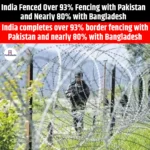11 Years of Garib Kalyan
|
General Studies Paper II: Issues Related to Poverty and Hunger |
Why in News 11 Years of Garib Kalyan?
Recently, on June 5, 2025, marking 11 years of Garib Kalyan (welfare of the poor), the Central Government highlighted its achievements in these 11 years that every policy has been dedicated to people’s service, good governance, and the welfare of the underprivileged.
How was the Foundation of Garib Kalyan Laid?
- Poverty eradication in India has long been a challenging subject. After 2014, the Central Government adopted it as a primary goal.
- During this period, the method of policy formulation changed, schemes were made beneficiary-centric, and digital transparency was promoted.
- After 2014, the government did not limit poverty only to a lack of income. It was viewed in connection with health, education, housing, nutrition, and social respect.
- The government placed public participation at the center of these efforts. Gram Sabhas, local bodies, and volunteer organizations were involved in scheme formulation and implementation.
- Direct money transfer to beneficiaries’ accounts proved to be a successful policy.
- The DBT (Direct Benefit Transfer) system was strengthened through Jan Dhan accounts, Aadhaar numbers, and mobile linking.
- To bring the poor into the mainstream of society, the government emphasized social inclusion. Schemes were implemented equally for all, rising above discrimination based on caste, religion, gender, or region.
- The government moved away from uniformity and accepted local diversity in schemes. Forest rights in tribal areas, transport allowances in hilly regions, and new housing schemes for urban poor were introduced.
Major Garib Kalyan Schemes
- Pradhan Mantri Jan Dhan Yojana (2014): This scheme aimed to connect every citizen with banking services. Previously, those without bank accounts could now receive government assistance directly into their accounts. Jan Dhan accounts also offered RuPay cards, insurance cover, and interest-bearing savings.
- Pradhan Mantri Ujjwala Yojana (2016): Earlier, women cooked by burning wood in smoky environments, which adversely affected their health. The Ujjwala scheme not only made kitchens safer but also saved women’s time and labor.
- Pradhan Mantri Awas Yojana (2015): The government’s goal is for every person to have a dignified home. This initiative ensures that economically weaker sections in both cities and villages have access to strong, permanent housing. Basic facilities like toilets, electricity, and water are also included in the house construction.
- Ayushman Bharat Yojana (2018): Ayushman Bharat allows underprivileged families to get hospital care worth ₹5 lakh annually, free of cost, in both public and private healthcare facilities. Where the poor previously suffered due to lack of treatment, they now have a guarantee of health.
- Pradhan Mantri Kisan Samman Nidhi (PM-KISAN: 2019): This scheme provides financial assistance of ₹6,000 annually to small and marginal farmers. Funds are deposited straight into beneficiaries’ bank accounts, preventing any misuse or third-party interference. This scheme helps farmers purchase seeds, fertilizers, and equipment, supporting agriculture.
- Mahatma Gandhi National Rural Employment Guarantee Scheme (MNREGA: 2006): This scheme ensures 100 days of employment for unemployed individuals in villages. Under this, construction work like roads, ponds, and wells are carried out, which also improves rural infrastructure.
- Saubhagya Yojana (2017): The aim behind this program was to ensure that every home in the country had access to electricity without exception. Free connections were given to homes that had not yet received electricity. Electricity not only made studying easier but also improved employment and safety.
- Har Ghar Jal Abhiyan (2019): This mission was introduced to make clean drinking water through household taps a reality for all families. In villages, women used to walk several kilometers daily to fetch water, and now this difficulty has been reduced. This scheme aims to improve the quality of life, along with health and time savings.
- Pradhan Mantri Garib Kalyan Anna Yojana (2020): During the difficult period of the pandemic when livelihoods had stalled, the government fought hunger by providing free rations. Essential items like wheat, rice, and pulses reached crores of people, ensuring that no one went to bed hungry.
- Pradhan Mantri Garib Kalyan Package: During the pandemic, the government provided facilities such as financial assistance, free gas cylinders, old age and widow pensions, and insurance for healthcare workers to the poor. This package emerged as a support in times of crisis.
Achievements of Garib Kalyan Schemes
- Pradhan Mantri Jan Dhan Yojana (PMJDY): Taking a big leap towards financial inclusion across the country, this scheme has opened over 52 crore bank accounts. While the deposit amount in accounts was previously limited, it has now increased to over ₹2.32 trillion.
- Women’s participation: 55.6%.
- Pradhan Mantri Ujjwala Yojana (PMUY): Making cooking gas a means of freedom from wood and smoke, this scheme has so far provided LPG connections to 10.33 crore households. Under Ujjwala 2.0, 2.34 crore new beneficiaries have also been added, making kitchens safer and cleaner.
- Pradhan Mantri Awas Yojana (Urban): The dream of pucca houses for homeless people in cities has now become a reality. Out of nearly 117 lakh homes approved under the scheme, more than 93 lakh have already been built and handed over to beneficiaries.
- Ayushman Bharat Yojana: To free health from financial burden, this scheme has proven to be a boon. So far, over 11.4 crore eligible people have been issued health e-cards. This has enabled free treatment worth ₹9,205 crore and provided hospital admission facilities 1.09 crore times.
- PM-KISAN Scheme: This historic initiative, providing financial assistance directly to farmers’ accounts, has so far benefited 9.8 crore farmers. The annual assistance of ₹6,000 is provided in three installments through Direct Benefit Transfer (DBT), with increasing participation from women.
- Mahatma Gandhi National Rural Employment Guarantee Scheme (MNREGA): This scheme, which creates employment opportunities in rural India, has written a new chapter of change in the last decade. 266 types of works have been approved, a large number of which are related to agriculture and natural resource management. Assets in villages have grown at a rate of 526%, and women’s participation has now reached 58%.
- Jal Jeevan Mission: The primary objective of this scheme is to increase access to tap water in rural homes. To ensure clean water access in villages, piped water supply has reached over 5.38 crore rural households to date. This means approximately 45% of rural families are now getting access to clean water.
- Pradhan Mantri Garib Kalyan Anna Yojana (PMGKAY): During the difficult time of COVID-19, over 81 crore people were provided free grains under this scheme.
- Pradhan Mantri Garib Kalyan Package (PMGKP): Under this, over 42 crore citizens were provided assistance of ₹68,820 crore. Women account holders received ₹30,952 crore in three installments, the elderly, widows, and divyang (persons with disabilities) received ₹2,814 crore, and construction workers received ₹4,987 crore in assistance.
Current State of Poverty in India
- Over the last decade, basic facilities have entered the lives of crores of people. The fact that water, electricity, education, and healthcare services have now reached these individuals has become the true hallmark of India’s poverty eradication.
- In 2011-12, 16.2% of the country’s population was living on less than $2.15 per day. This number has fallen to just 2.3% in 2022-23.
- In rural India, the poverty rate, which was previously 69%, has come down to 32.5%. In urban areas, poverty has decreased from 43.5% to 17.2%. However, challenges in rural areas remain significant.
- According to NITI Aayog, multidimensional poverty, measured by combining education, health, and standard of living, was 29.17% in 2013-14, which has decreased to 11.28% in 2022-23.
- States like Uttar Pradesh, Bihar, Odisha, Madhya Pradesh, and Rajasthan have registered the most significant decline in poverty.
Effective Strategies for Poverty Eradication
- Quality Education: Quality and practical education connects children with better livelihood opportunities. Real change can be brought about by increasing the availability of digital tools, trained teachers, and content in local languages in government schools.
- Diversification of Livelihoods: Employment options in villages are often limited to agriculture. Promoting handicrafts, animal husbandry, fisheries, rural tourism, and rural industries can strengthen the local economy.
- Financial Inclusion: Access to bank accounts, insurance, pensions, and digital payments makes the poor economically secure. Now, the need is to ensure simple loans, insurance awareness, and digital literacy for every individual.
- Skill Development and Employment Generation: It is important to link skill development programs like PMKVY with small industries, the service sector, and the digital sector. Post-training guidance and employment guarantee can secure the future of youth.
- Solar Energy Solutions: Small farmers depend on high-cost electricity or diesel, which reduces their income. Solar energy can reduce the cost of irrigation, storage, and processing. Expansion of programs like the KUSUM scheme will lead farmers towards energy self-sufficiency.
- Region-Specific Poverty Strategies: The causes of poverty vary from state to state, so a single policy cannot be applied everywhere. Separate strategies will need to be made for desert, hilly, tribal, and coastal areas. Data-driven schemes and grassroots participation can reduce regional inequality.
- Role of Public-Private Partnership (PPP): If the government and the private sector invest together in basic services, education, health, and infrastructure, the results can be rapid and sustainable. In the PPP model, accountability, transparency, and a beneficiary-centric approach must be prioritized.









